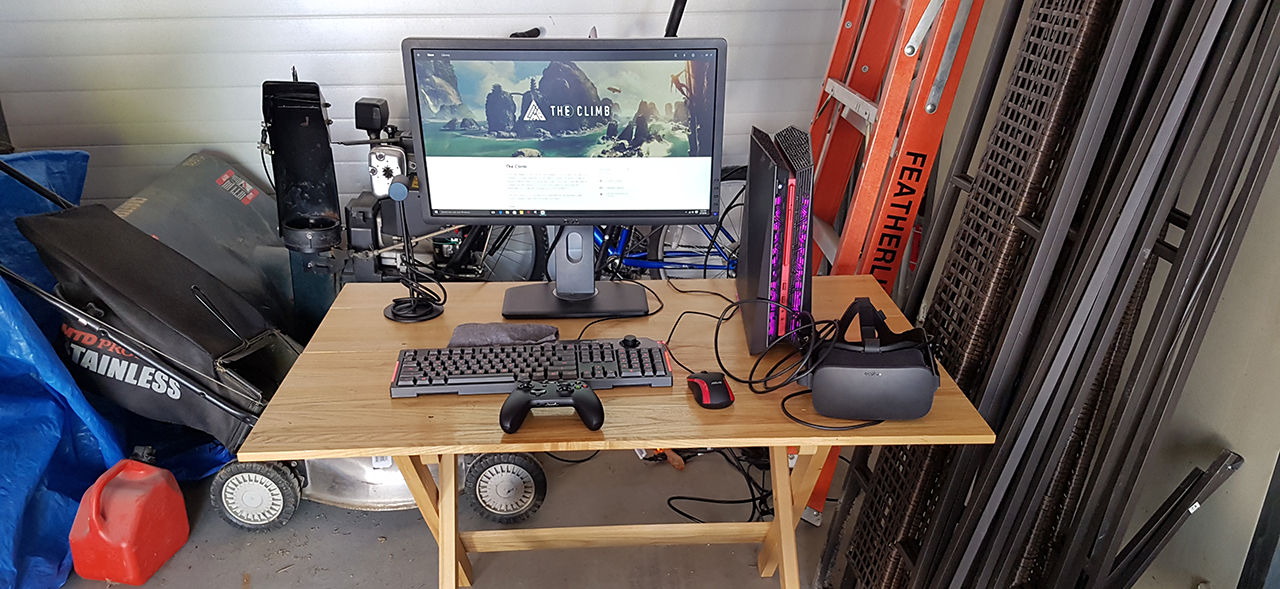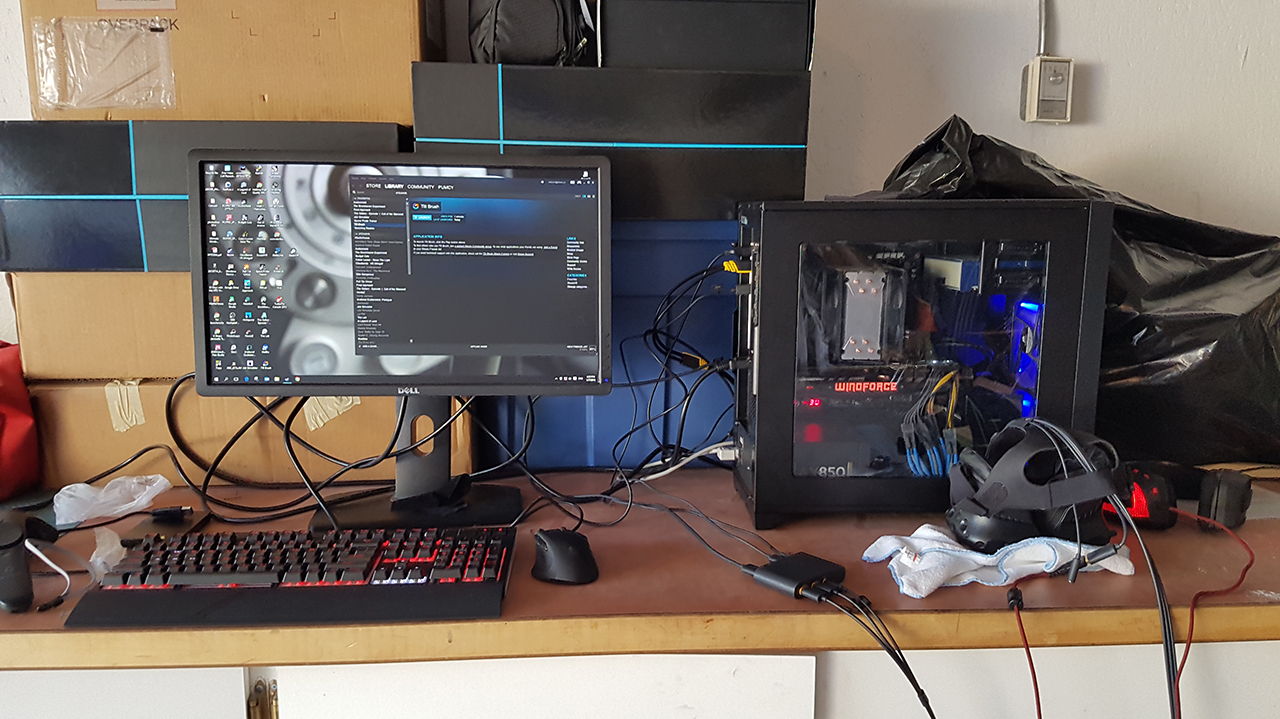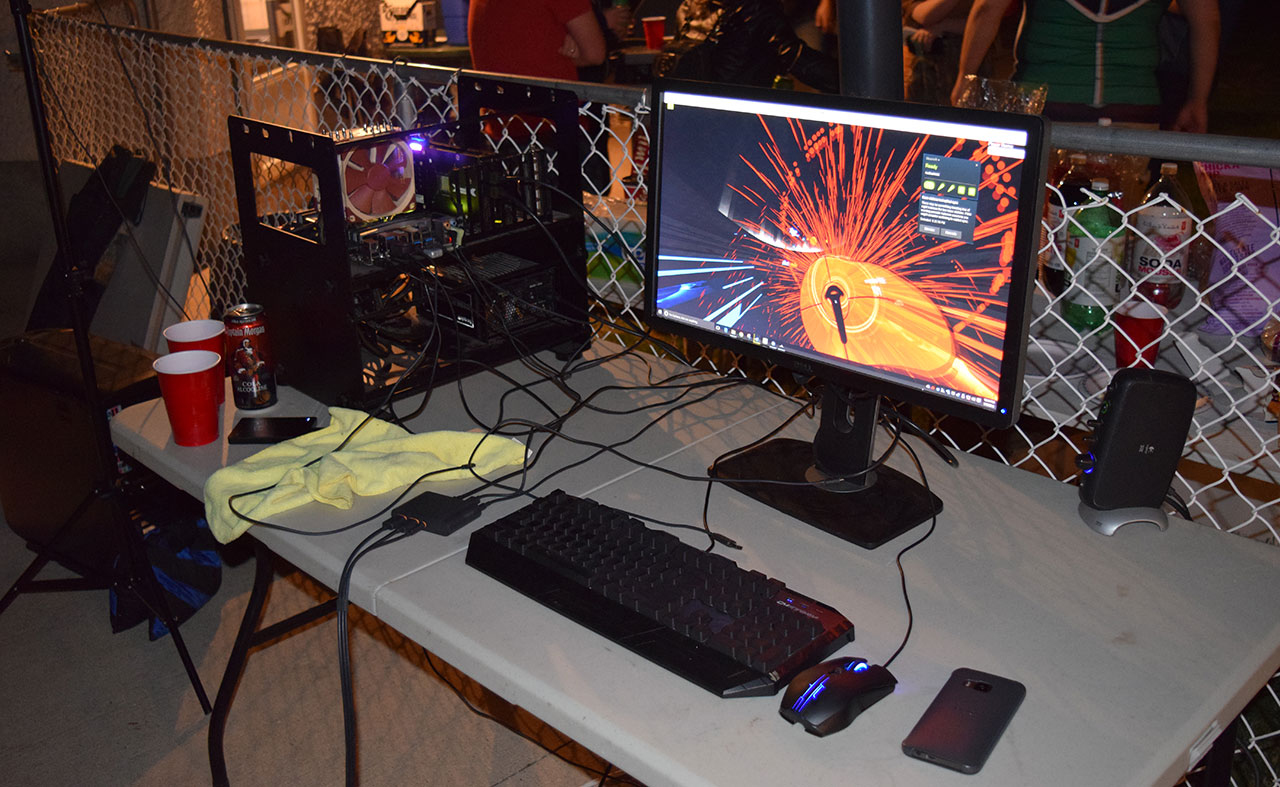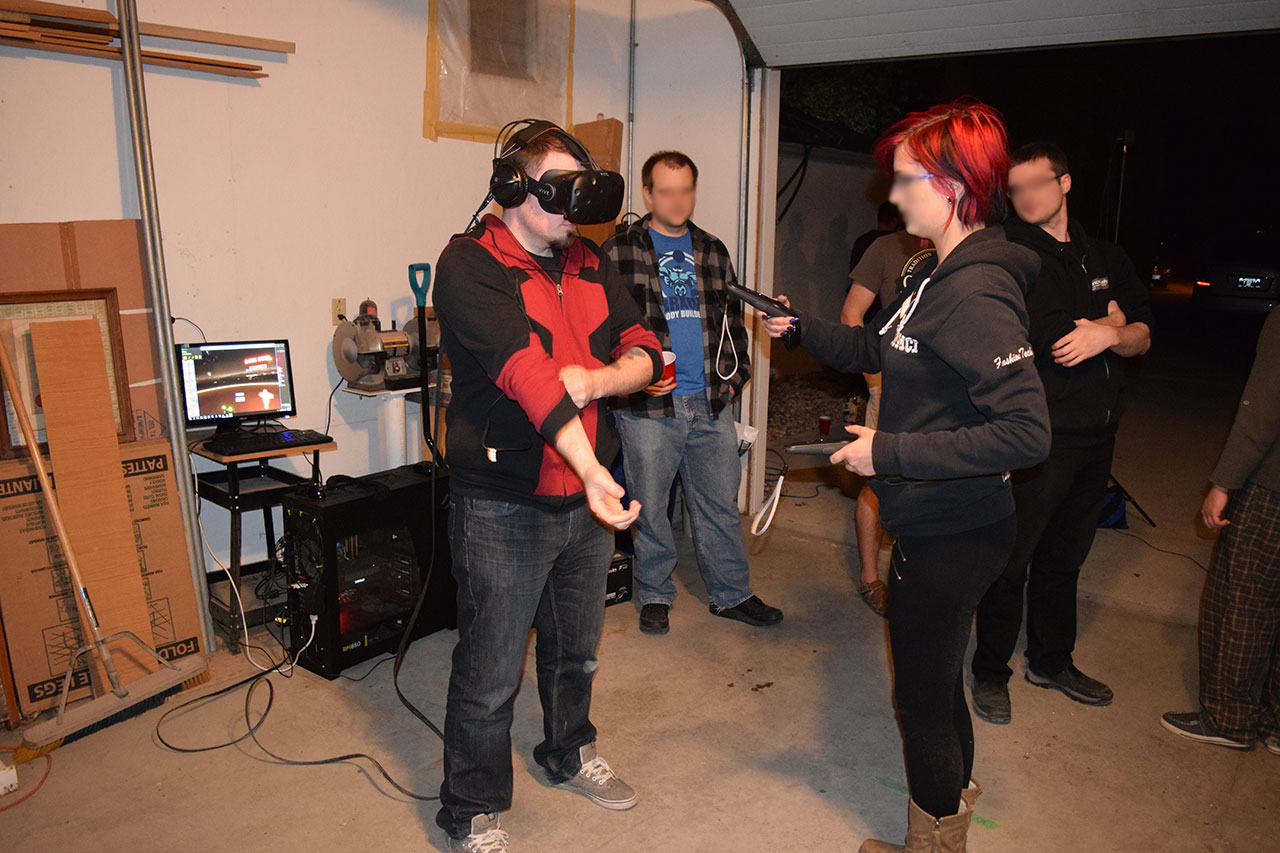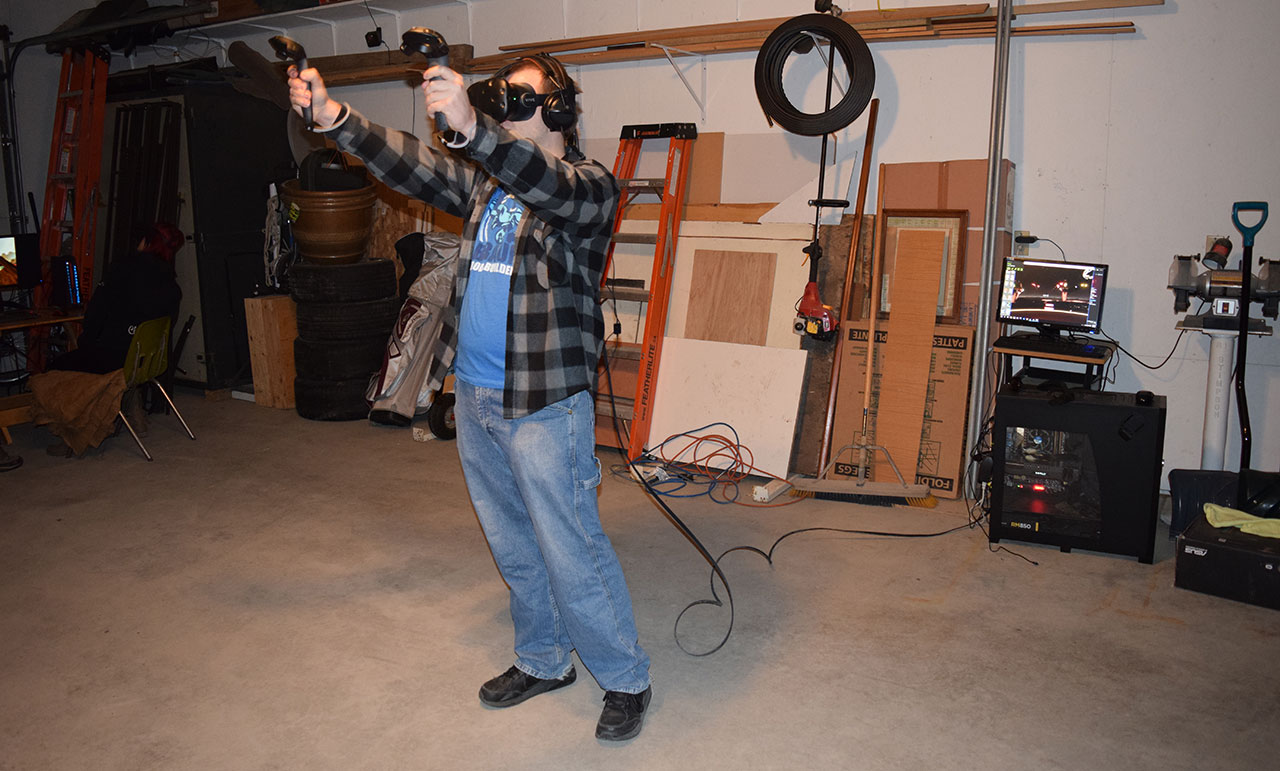Throwing (And Troubleshooting) A VR-Sharing Party
Recently, I had more than 30 friends over for a BBQ, a bonfire and some drinks to share with them the virtual worlds I’ve been living in for the last two months. You may think that VR is an antisocial experience, but I assure you, not one of the people who came to the party left with that opinion.
Virtual reality hardware is starting to land in the hands of early adopters now with the Oculus Rift and HTC Vive, but it’s safe to say that most people haven’t had the chance to experience PC-connected VR yet. Those who have already ordered VR hardware likely fall into two categories: People who have been lucky enough to try it and were convinced of its value, or those who haven’t tried it but are willing to throw large sums of money down in blind faith. That really doesn’t add up to a large portion of the populace...yet.
VR is, in its current iteration, a brand new medium that has uniquely difficult-to-describe characteristics. Ask anyone who’s tried VR and they will agree that you have to experience VR to understand it—to really “get it.” In some ways, the VR industry is banking on the idea that early adopters will share VR with their friends, which will inspire more people to buy hardware. I believe that sharing VR will be the quickest path to widespread adoption, or at least acceptance. Just the fact that I have these VR kits at my disposal makes me feel somewhat obligated to share it with everyone that I can.
And through sharing it, I found a few issues with setting things up and running these HMDs for hours on end, and we learned a few things about how people react to and experience VR.
Big Affair, Lots Of Gear
On the surface, having a bunch of friends over so they can try out the latest and greatest in VR technology that sounds simple, but the execution turned out to be quite a production, with four VR machines going at once.
The equipment list for the night included an Oculus Rift and three room-scale Vive systems (Tom’s Hardware’s Vive Pre and Vive, and an additional Vive graciously loaned to me by AYBOnline.com, an organization I volunteer my time for.)
The computers that were used to run the event included:
Get Tom's Hardware's best news and in-depth reviews, straight to your inbox.
An Asus Oculus Ready PC, which featured an Intel Core i5-6400 and a GeForce GTX 970. This PC powered the Oculus Rift headset.
My personal VR system, with a Core i5-4690k and a Zotac GeForce GTX 980 Ti AMP! Extreme, was used for one of the Vives that were inside the garage.
My daily use PC, which has a Core i7-2600K and a Gigabyte GeForce GTX 980 Ti Xtreme Gaming, powered the second garage Vive.
The Tom’s Hardware test system with an Intel Core i7-5930K and an XFX Radeon R9 Fury was used for the Vive Pre, which was set up outside.
Mistakes, I Made A Few
The party was held at my mom’s house (Thanks Mom!—the day before mother’s day too. She’s an angel) so that I could use her garage for the VR systems. The idea was to install two Vives inside the garage, along with the Oculus Rift. The third Vive would be outside and hooked up to speakers. It would serve as group entertainment.
I made a few mistakes.
For one thing, I wanted to try and use two Vive systems with one set of base stations. That was my first mistake. I also wanted to test how far the base stations could really be from each other. That was my second mistake, and it compounded the first one.
I did test the two Vive systems out before the guests arrived. I had set the base stations up several days before and made sure that they worked with one Vive system. I noticed a few tracking hiccups, but I decided they were minor enough to ignore. That was my third mistake. The day of the party, I brought the other Vive over and had a friend help me test them out together. Our test was successful, so the base stations remained where they were. SteamVR was giving us a warning about being well beyond the recommended range of 5.5 meters, though, and we should have headed that warning.
The desire for two large playspaces in the garage fueled my decision to ignore the range and tracking warnings. We gave each Vive 4 x 2.8 meters, which actually worked out very well--when it worked at all. My smaller play space at home is 1.9 x 2m, and it feels cramped for some games, but the large play space in the garage never felt cramped at all.
Don't Touch The Tripods!
The Vive Pre was to be used as our music entertainment for the night. I set up this system on the driveway, in front of the garage. We used tripods to hold the sensors up, and we put the PC on a folding table. This system was connected to speakers, instead of headphones, so that the partygoers could hear what we going on.
HTC and Valve recommend that your base stations point down to the center of your play space at a 30- to 45-degree angle, and they should be positioned at least 6.5 feet in the air. Most camera tripods don't go high enough for the base stations, so we used photography light stands instead. These tripods don't offer a tilt option, so pointing them at the ground was out. Fortunately, the lighthouse system is very forgiving. Even though the base stations were sitting level, they worked just fine.
To compensate for being unable to point them down, we spread the base stations out as far as possible, positioned approximately 5.7 meters from each other. The only tracking issue we experienced was during the initial calibration. It took several attempts to calibrate the floor correctly, possibly due to the base station position.
The biggest problem we experienced happened when someone bumped into one of the tripods. My brother had the HMD on when this happened, and it instantly set his balance off. When the base station was moving, the horizon shifted approximately 30-degrees. We had to restart SteamVR to reset the horizon. The headset re-calibrated itself upon relaunching SteamVR. It didn't require the room setup to be run again.
Trouble(shooting) In Party Paradise
The downside of hosting a party with four computers and four VR devices is that you don’t really get to relax very much. I spent half of my evening troubleshooting various problems. Tracking issues were the bane of my existence on Saturday night.
At first we thought the problem was from people crowding the play area, but we soon realized there were bigger issues afoot. Most of the time it was a problem with someone standing in the way, occluding the signal--but other times there was no one else in the garage.
As I mentioned, during setup I had some weird tracking issues that I naively ignored. The problems stemmed from having the base stations situated too far apart from each other. I used the sync cable, but apparently that doesn't let you go beyond the maximum distance, especially not this far. The recommended gap shouldn't exceed 5.5 meters, and these base stations (the ones in the garage) were 6.7 meters from each other.
Throughout the night, both Vives randomly occasionally lost tracking. The Vive on the left side of the room would occasionally lose tracking completely for one of the controllers. The Vive on the right side had what I'll call precision issues. It didn't seem to ever lose tracking completely, but the right hand was slightly off center; for example, if you tapped the controllers together in real life, there would still be a slight gap between them in VR.
Each of the three Vive computers ran more or less constantly for hours on end, and each one had to be rebooted once throughout the evening. All three systems had the same issue: One controller would drop tracking, come back, and then drop tracking a few seconds later. Rebooting the computers seemed to fix each at first, but the problems seemed to get worse throughout the night. I believe battery power might have contributed to our tracking woes, but the controllers were far from dead at the end of the party.
The Rift PC was the only one that didn’t give us any trouble while we were using it, although it did crash when it was left idle at the end of the night. After four hours of running Rift games, the computer went to sleep, and the graphics driver crashed. Because that makes perfect sense, right?
No Accidents
Going into this party, I was concerned about the very real possibility that by the end of the night there would be less than three working Vives left standing. I expected that at least one person would either trip on the cable or drop a controller, but no one even leaned on a virtual table or ledge. I was even more nervous that two people playing with Vives would smash into each other because someone ignored the chaperone.
But in the end, none of those things happened. Ironically, I was the only person to snag on the tether throughout the night. During a particularly active round of Space Pirate Trainer, the cord got caught on my foot and was yanked from the link box. None of the people new to VR were that adventurous within the headset. Everyone was somewhat cautious.
The fact that nothing got damaged and no one tripped is amazing to me. I didn't have time to explain how the systems work to everyone at the party, but everyone figured it out. The people who knew how to use the hardware were helping newcomers get situated and into a game of their choice. I didn't have to give explicit instruction to everyone, and I think that says a lot about how intuitive VR really is. Apart from getting some help putting the headset on, everyone just picked it up and knew what to do.
(Almost) No Dizziness
There were over 30 people at the party this weekend, and throughout the night--even with the recurring tracking issues--I didn’t hear anyone complain about the Vive experience once. The reactions were more in line with “That was amazing!” and “That was far better than I was expecting.” Even when the tracking did give them trouble, everyone thought the problems were acceptable, given the fact that there were two systems running off of one set of base stations.
There was some feedback about the Rift. A few people noted that they felt a little bit dizzy while playing some games, but no one got sick to the point where they had to lay down or leave, and no one felt like throwing up. The most common comment that I heard about the Rift was that it’s just not as good as the Vive. No one mentioned anything about the weight, and no one complained about the visuals in either headset, but there seemed to be a consensus that the room-scale experience was far superior.
That's not to say that people didn't enjoy the Rift. Many people tried it, and at least one person seemed to prefer the seated experiences rather than the room-scale games we had going on the Vive. The Climb certainly had the attention of a few people.
One of my friends was a Rift Kickstarter backer. He was so blown away by the Vive experience that he decided not to even open his Rift (he had just received it). He’s going to sell it and order a Vive instead. He’s not the only one that said they are ordering a Vive, either. One of my other friends had already ordered a Vive for himself after doing a play test at my house last month. Another was heavily considering a Vive before the party, and his experience with it this weekend put him over the edge. Several other people noted they are looking forward to the price of entry coming down in the next year or two, because they would like to buy one but can't justify the cost of an HMD and a PC at the same time.
What Did I Learn For Next Time?
Having gone through the effort of hosting this party, I've learned a few things. First and foremost, it was a smash hit. Every single person that came to the party was blown away, and nearly a dozen asked to do it again. All it took was just one taste of VR to rid the room of any skepticism. If this party is any indication of how well VR will be adopted, I think we're about to see some exponential growth over the course of the year.
Though it was a tremendous success, I doubt I will do it again in this format. Having four systems to babysit is too much. All of my friends had an amazing time the whole night, but I was running around fixing issues and worrying about possible damage. Having two setups is probably all you would ever really want, unless you had people there specifically to help run the VR demos.
A viewing space is also necessary. Everyone wanted to see what the players were seeing, but it was hard to watch a 23-inch screen from 10-feet away. A projector screen would be ideal, so that everyone could watch what was going on without huddling around the player.
I would also suggest that you keep your configuration within the specified parameters. A larger tracking space sounds wonderful, but eliminating tracking issues is crucial if you don't want to be constantly trying to get things working. It's also probably a good idea to use separate base stations for each headset. Though it did technically work, a smaller tracked area would have made the play areas very cramped. A partition in the middle of my garage and both sets of base stations would have been a better idea.
Follow Kevin Carbotte @pumcypuhoy. Follow us on Facebook, Google+, RSS, Twitter and YouTube.
Kevin Carbotte is a contributing writer for Tom's Hardware who primarily covers VR and AR hardware. He has been writing for us for more than four years.
-
Flame_Runner_Fast Very informative article! I definitely plan to get the Vive in a few years...as I have more than enough Steam games I want to play (like at least 30 of my 90), and that $800 price tag for the Vive is really expensive...Reply
I would rather get the Vive at at the max $550, no more. Plus college dorms are rather cramped...so I'm not sure if I could get a roommate who would be willing to share that much space when I would play a Vive game...
Additionally there are already better HMDs coming out, so I would rather wait for a better and more fancier experience than what I could get now... -
Xanvronly Thanks for sharing your experience! I'm about to start a long career in promoting VR in Brazil, and I'm about to give my second presentation, but now in another level, as my Vive arrived last Friday, which may be the first CV1 in my country, and I would like to know some other details so that I can apply to my presentations. Did you time each user's experience? If so, how long? Did you clean the headsets after they used it? How? Did you use anything to avoid the tripod to vibrate? That's all for now I guess. Thanks in advance!Reply -
Rancifer7 Great article on something I bet a bunch of us with Vive's was considering, though not on this scale. Thanks.Reply -
Xanvronly Thanks for sharing your experience! I'm about to start a long career in promoting VR in Brazil, and I'm about to give my second presentation, but now in another level, as my Vive arrived last Friday, which may be the first CV1 in my country, and I would like to know some other details so that I can apply to my presentations. Did you time each user's experience? If so, how long? Did you clean the headsets after they used it? How? Did you use anything to avoid the tripod to vibrate? That's all for now I guess. Thanks in advance!Reply

